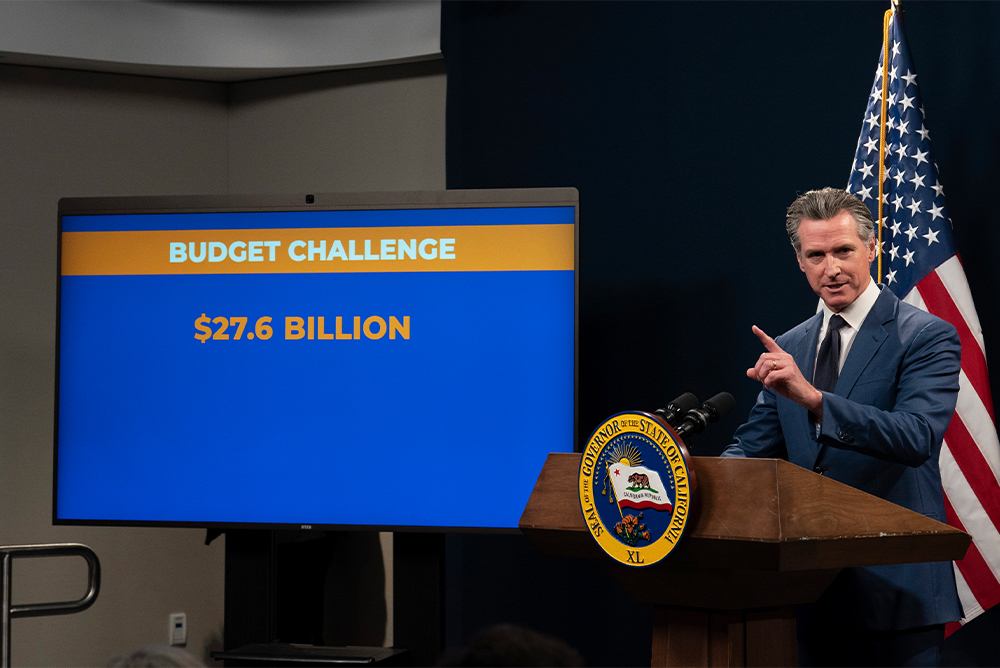
California’s constitution is full of guarantees and formulas that ratchet up spending on favored programs, writes columnist Joe Mathews, even when revenues drop and the budget is out of balance. California Governor Gavin Newsom during a news conference on May 10, 2024. Courtesy of AP Photo/Rich Pedroncelli.
You can tune out Gov. Newsom when he talks about the state’s big budget deficit. Ignore the pleas of Democrats who control the legislature, too. And turn the volume down when Sacramento lobbies complain about the proposed cuts.
California’s ballooning budget deficits, and the cuts to services they cause, are not a crisis. They are not really news. They are, sadly, normal and predictable.
And they are grounded not in budgeting mistakes—lapses of discipline in collecting revenue or controlling spending—but in our state constitution and in a reality so paradoxical it would make Kafka blush:
Our constitution requires the state to balance its budget. But balancing the state budget requires violating the state constitution.
How’s that? Because on fiscal matters, our constitution is effectively a ratchet. The document is full of guarantees and formulas, approved by voters, that ratchet up spending on favored programs, even when revenues drop and the state budget is out of balance.
Meanwhile, the constitution also has plenty of voter-approved limits on taxes and fees. These limits ratchet down revenues in slower economic times and make it harder for the state and local governments to raise revenues to cover budget increases.
Californians may have forgotten about the ratchet. The past decade was an unusual one for the state budget, as stock market growth and federal pandemic relief sent government revenues soaring and created surpluses.
But with those revenue sources gone or declining, California’s Kafkaesque constitution is reasserting itself and producing deficits projected recently to range anywhere from $27 billion to $70 billion.
That leaves Gov. Newsom stuck and left to do with the budget what all California governors must:
Violate the constitution.
First, he’s not offering a balanced budget. The spending delays, draw-downs on reserves, and cuts he’s proposing to state operations eliminate only about half of the deficit.
Second, to close the gap, he’s violating the state’s education funding guarantee, a voter-approved formula called Prop 98.
Prop 98 is, famously, so complicated that no one really understands it. (It involves three complex formulas to determine state funding, and it’s never clear really clear which formula will apply in which year.) The main effect of Prop 98 is to keep pushing education spending up; it’s one of the biggest spending ratchets in our constitutional budget ratchet.
Newsom’s maneuver is a sneaky ploy to reduce Prop 98’s ratchet effect by changing the inputs to the formula. Newsom’s budget proposes to travel back in time and reclassify certain moneys spent on education in previous years as non-education spending.
This maneuver is intended to lower the funding base underneath the formulas—helping him “balance the budget” while allowing the ratchet to do its work.
The problem (besides the inherent ridiculousness of having to bend the law in this manner) is that the lower funding base would mean tens of billions less in school funding in future years.
Yes, my fellow Californians, “screw the kids” remains the real, if unofficial, state motto.
The powerful education lobby is crying foul, as are some Democrats and local governments. Newsom defends himself by saying he’s required to balance the budget.
The problem with this blame game—and demands that Newsom reverse the cuts—is that it defines the discussion as being about the budget. The real problem is California’s broken constitution.
Finding tens of billions of dollars in cuts for anything is hard. Health programs have all kinds of court-ordered, statutory, and, in some cases, constitutional protections. Cuts to prisons and state agencies require concessions from politically powerful labor unions. Tax increases run up against Prop 13 and other state revenue limits.
That doesn’t mean I’m trying to let Newsom, the Democratic supermajority in the legislature, and other powerful Sacramento interests off the hook for the state’s budget problems. It’s the exact opposite. The governor, Democrats, and interest groups are responsible for the budget mess—because they’ve had plenty of time to fix the constitution, and haven’t even tried.
Gavin Newsom has been in statewide office since 2011. California Democrats have had full control of Sacramento since that same year. And powerful unions and other lobbies have held sway for far longer than that.
All of these politicians and lobbies know very well that the California constitution is broken. They have long had the power to come together and give the state the new constitution it needs—without all the fiscal ratchets that drive up spending and limit revenues.
But they haven’t been willing to lead and change the system. They have focused instead on building their own power within this broken system. Jerry Brown and other California leaders have spent the past decades dismissing calls for a constitutional rewrite (including my own, via the book California Crackup) as unrealistic.
But state leaders are the ones who have lost touch with reality. They claim they can fix the budget, but they can’t because the constitution won’t let them. And they won’t fix the constitution because they say it’s politically impossible. How long can they keep saying this—and keep pretending they are doing their jobs?
When the governor and legislators say they are trying to solve the problem, they aren’t telling the truth. This miserable budget, full of cuts to education, is a product of the budget system, and the constitution, that they themselves have chosen.




Send A Letter To the Editors